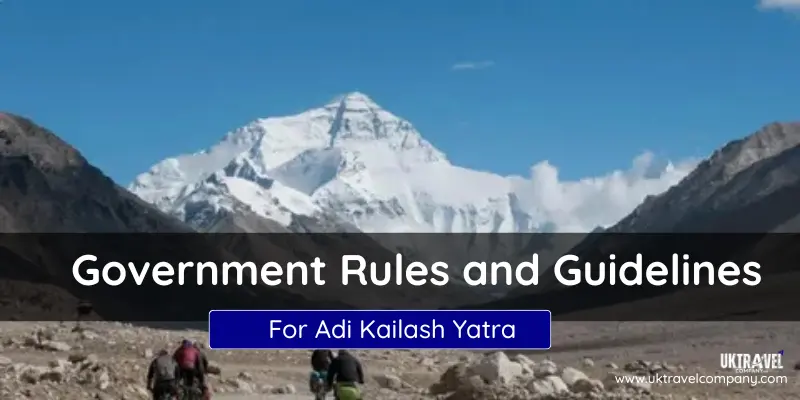Table of Contents
Introduction
One of India’s oldest pilgrimage locations is Adi Kailash, sometimes called Chhota Kailash. Located in the Pithoragarh district of Uttarakhand near the Indo-China border, this holy mountain is believed to be the abode of Lord Shiva and Goddess Parvati. Thousands of devotees undertake the Adi Kailash Yatra every year to seek blessings and experience the divinity of the Himalayas.
Since the route is situated in a high-altitude, sensitive border region, the Government of India and the Uttarakhand Tourism Department have set specific rules and guidelines. These ensure not only the safety of pilgrims but also the preservation of the fragile Himalayan environment. Here is a detailed guide to the government rules and regulations every devotee must follow during the Adi Kailash pilgrimage.
1. Registration Rules
- All pilgrims must complete mandatory registration with the Uttarakhand Tourism Development Board (UTDB) or Kumaon Mandal Vikas Nigam (KMVN).
- Valid ID proofs such as Aadhaar card, passport, or voter ID are required.
- A medical fitness certificate from a government-approved hospital is compulsory before approval.
- Registration fees and permit charges vary depending on the route and facilities chosen.
Tip: Register well in advance as limited seats are available for each batch.
2. Age and Health Guidelines for Adi Kailash
- The yatra is open to individuals between 18 to 65 years of age.
- Pilgrims must be physically fit to endure long treks, cold weather, and high altitudes.
- People with heart problems, high blood pressure, asthma, or chronic illnesses are usually not permitted.
- Pregnant women and minors below 18 are restricted from the pilgrimage.
Why it matters: The journey passes through altitudes above 12,000 feet, where oxygen levels are low, making fitness essential.
3. Travel Permits and Security Rules
- As the region is close to the Indo-China border, an Inner Line Permit (ILP) is mandatory for both Indian and foreign pilgrims.
- Foreign nationals need additional approval from the Ministry of Home Affairs.
- Original ID documents and permits must be carried at all times.
- Security checks are conducted at various points along the route, and compliance is mandatory.
4. Environmental and Safety Guidelines
- The government strictly enforces a “No Plastic Zone” policy. Carry cloth bags and refillable water bottles instead.
- Littering, cutting trees, or polluting rivers and lakes is strictly prohibited.
- Trekkers must follow designated trails and avoid risky shortcuts.
- Groups must stay together, and solo trekking is discouraged for safety reasons.
- First-aid centers and emergency rescue teams are available along the route.
Eco-friendly reminder: The Himalayas are fragile, and preserving their sanctity is the responsibility of every pilgrim.
5. Accommodation and Food Rules
- Accommodation is mainly arranged by KMVN guest houses, tents, or local lodges.
- Pre-booking is advised since facilities are limited in remote areas.
- Vegetarian meals are provided during the yatra. Carrying alcohol, non-vegetarian food, or smoking materials is prohibited.
- Open cooking in forested areas is not allowed due to fire risks.
6. Transport and Route Guidelines
- Pilgrims travel through a combination of vehicles, trekking, and ponies in difficult stretches.
- Only government-approved vehicles and licensed guides are permitted.
- All pilgrims must report at designated check-posts during the journey.
- Avoid traveling after dark as routes can be dangerous in low visibility.
7. Code of Conduct for Pilgrims
- Respect the local customs, temples, and traditions of the Himalayan villages.
- Dress modestly and maintain discipline at sacred sites.
- Loud music, alcohol, smoking, or disrespectful behavior is strictly prohibited.
- Photography is restricted in military and security-sensitive areas.
8. Emergency and Helpline Services
- The Uttarakhand government provides 24/7 helpline numbers for pilgrims.
- Medical aid centers and rescue facilities are available in case of high-altitude sickness or accidents.
- Army and ITBP (Indo-Tibetan Border Police) provide assistance in emergencies.
- Pilgrims are encouraged to take travel insurance for added safety.
Explore Our Adi Kailash & Om Parvat Yatra Packages
Adi Kailash Yatra Package From Dharchula
Adi Kailash Yatra Package From Delhi
Adi Kailash Yatra Package From Kathgodam, Haldwani
Adi Kailash Yatra Package From Pithoragrah
Conclusion
The Adi Kailash Yatra is more than just a journey—it is a spiritual calling that requires faith, discipline, and responsibility. By following the government rules and guidelines, devotees not only ensure their own safety but also help protect the sacred Himalayas for future generations.
A pilgrimage to Adi Kailash is an opportunity to connect with LordShiva in his divine abode. With proper preparation, respect for nature, and adherence to rules, this yatra can truly become a once-in-a-lifetime spiritual experience.
FAQs on Government Rules and Guidelines for Adi Kailash Yatra
-
What are the age limits for Adi Kailash Yatra?
The pilgrimage is generally open to devotees between 18 to 65 years of age. Children below 18 and senior citizens with serious health conditions are not allowed.
-
Is registration mandatory for Adi Kailash Pilgrimage?
Yes. All pilgrims must register with the Uttarakhand Tourism Development Board (UTDB) or Kumaon Mandal Vikas Nigam (KMVN). A valid ID and medical certificate are required.
-
Do I need a permit for the pilgrimage?
Yes, Inner Line Permit (ILP) is mandatory.
-
What items are restricted during the yatra?
Alcohol, smoking items, non-veg food, and plastic.
-
Are safety and medical facilities available?
Yes, medical aid, rescue teams, and army support are provided.



